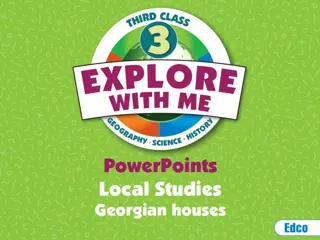The Art of Georgian Acting: 1714-1830
Delve into the world of Georgian acting from 1714 to 1830 through the eyes of insightful texts and practical illustrations. Explore the nuances of rhetorical gesture, mimic expression, and theatrical eloquence as described by prominent figures in acting history. Uncover the blend of articulation, corporeal motion, and emotional expression that defines the essence of acting on stage, capturing the essence of human nature through the art of performance.
Download Presentation

Please find below an Image/Link to download the presentation.
The content on the website is provided AS IS for your information and personal use only. It may not be sold, licensed, or shared on other websites without obtaining consent from the author.If you encounter any issues during the download, it is possible that the publisher has removed the file from their server.
You are allowed to download the files provided on this website for personal or commercial use, subject to the condition that they are used lawfully. All files are the property of their respective owners.
The content on the website is provided AS IS for your information and personal use only. It may not be sold, licensed, or shared on other websites without obtaining consent from the author.
E N D
Presentation Transcript
GEORGIAN ACTING 1714- 1830 Georgina Lock Nottingham Trent University georgina.lock@ntu.ac.uk
Practical Illustrations of Rhetorical Gesture and Action, Adapted to the English Drama (1807) from Ideen Zu Einer Mimik (1785), Johan Jacob Engel (1741-1802) director of the National Theatre, Berlin. Influenced: Lessons on the Principles of Gesticulation and Mimic Expression by Johannes Jelgerhuis (1827)
Mr Fennel handsomely formed his eloquence, though lofty and sonorous, is neither varied nor judicious; and his deportment is rather encumbered by the stateliness of his person than rendered graceful by it. Reminiscences of Michael Kelly of the Kings Theatre and Theatre Royal Drury Lane, including a period of nearly half a century (1826)
Acting is an Entertainment of the Stage, which by calling in the Aid and Assistance of Articulation, Corporeal Motion, and Ocular Expression, imitates, assumes, or puts on the various mental and bodily Emotions arising from the various Humours, Virtues and Vices incident to Human Nature. An Essay on Acting in which will be considered The Mimical Behaviour of a certain fashionable, faulty Actor and the Inaudibleness of such unmannerly as well as inhumane proceedings. Printed for Mr Bickerton (1746)
Harmonious but not a lasting voice Treatise on the Passions, Samuel Foote. Garrick s trade was to represent passion, not to feel it. Samuel Johnson
... a fine voice is so strong a recommendation in a Theatrical Candidate that every defect is overlooked, or it alone, if united with a good ear and assiduity, is certain of bringing emolument and fame to its possessor. The coarse robustness of Mrs Kennedy ( who officiated in male characters in the vocal line ) was entirely overlooked when her powerful correct melody was heard. Joseph Haslewood, Secrets of the Green Room (1790) p 171
Kelly s Macheath (Drury Lane) was modelled on Mr Webster s Macheath: fine figure, baritone and sweet falsetto of which he made judicious use in The Charge is being prepared. Reminiscences of Michael Kelly, p46 Mr Bannister voice clear and strong and an extensive falsetto Secrets of the Green Room 1790 p35 ... sweet but too soft for anything but the tender passions Treatise on the Passions, on B---y s Voice p24 ... after hearing Mrs Siddons speak Farewell remember twelve the manner in which all other actresses have spoken them becomes intolerable. Remarks on Mrs Siddons p16
Samuel Foote - The word passion is applied to different Motions and Agitations of the Soul, according to different objects that present themselves to the senses; how or by what means this mutual Action or Communication between Soul and Body is effected remains a secret to us all. Our attempts to resolve it into anything prior or more simple have been fruitless and ineffectual. Samuel Foote, Treatise on The Passions so far as they regard the Stage with a critical enquiry into the theatrical merit of Mr G k, Mr Q n and Mr B y (1747)
Henry Siddons (1774-1815) by Samuel John Stump (1808) roles: Banquo, George Barnwell and Douglas to Sarah s Lady Randolph. became manager of Edinburgh Theatre.
Mrs Siddons displays a species of acting that I was little acquainted with; it partakes of the dignity of tragedy, enlivened by sharp ridicule and pointed raillery one would suppose the property of comedy yet they are united by Mrs Siddons in Margaret of Anjou with an effect that delights us by its novelty. Letters of a Lady of Distinction to her Friend in the Country. The Beauties of Mrs Siddons or a Review of Her Performance of the Characters of Belvedera, Zara, Isabella, Margaret of Anjou, Jane Shore and Lady Randolph. (1786) letter 4
unearthly appearance of Kemble his dress the look the tout ensemble struck me to be more than human. He was hailed with the most rapturous applause, but he stood motionless, with uplifted eyes and apparently regardless of public tribute. Micheal Kelly on Kemble in James Boaden, The Italian Monk (1796)
whenever you can forget an audience you will charm them. The Works of the Late Aaron Hill written for the Benefit of the Family (1753)
Liverpool 1770-80, tin-glazed earthenware, Guy Green ( 1729- 1803), V&A
Kitty Clive as the Fine Lady in Garricks Lethe (1747 ) Folger























